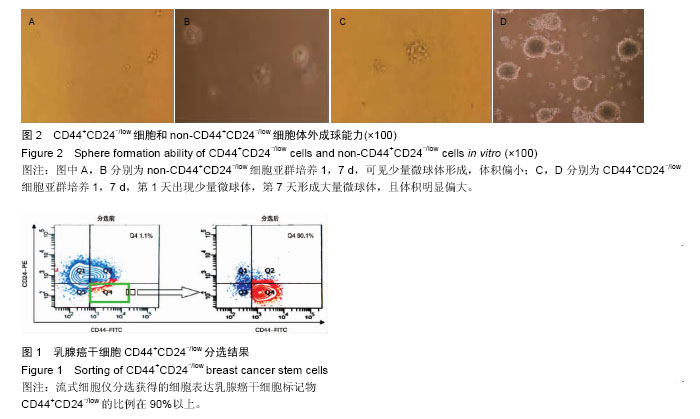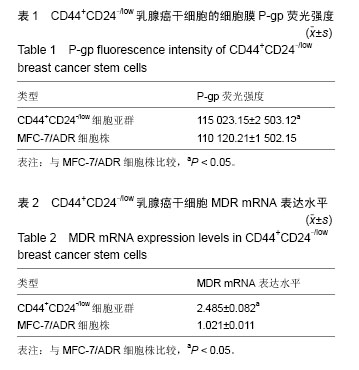| [1] 许立生,王水,黄中晶,等.CD44+/CD24-/low/ABCG2-乳腺癌干细胞与临床治疗及预后的关系[J].实用医学杂志, 2011,27(21):3877-3879.
[2] 张众,王华新,谢丰培,等.肿瘤干细胞与转移[J].临床与实验病理学杂志,2015,31(6):677-680,684.
[3] 李文涛,孙文聪,邓萌,等.人乳腺癌多西他赛耐药细胞株BT549/Docetaxel干细胞分选及三磷酸腺苷结合转运蛋白G超家族成员2基因表达水平[J].中华实验外科杂志, 2015,32(3):495-498.
[4] 史立纲.乳腺癌干细胞标志Sox2,Oct4与CD44+/CD24-/ low在乳腺癌不同基因类型中的表达及意义[D]. 郑州:郑州大学,2011.
[5] 李文鹏,罗维远,徐毅,等.下调Oct4基因表达对 MDA-MB- 231乳腺癌干细胞生物学特性的影响[J].中华肿瘤杂志, 2015,37(4):251-257.
[6] 李娈,董岩,王玲,等.β-榄香烯对MCF-7/ADM细胞株中乳腺癌干细胞作用的初步研究[J].临床肿瘤学杂志,2013, 18(8):683-687.
[7] 陈颖欣.乳腺癌干细胞的体外培养、分离、鉴定和乳腺癌相关基因表达及意义的研究[D]. 大连:大连医科大学, 2010.
[8] Bourguignon LY, Peyrollier K, Xia W, et al. Hyaluronan-CD44 interaction activates stem cell marker Nanog, Stat-3-mediated MDR1 gene expression, and ankyrin-regulated multidrug efflux in breast and ovarian tumor cells. J Biol Chem. 2008; 283(25):17635-17651.
[9] 王欣荣.化疗药物富集小鼠乳腺癌细胞系4T1中肿瘤干细胞及其耐药机制研究[D].石家庄:河北医科大学, 2010.
[10] Yang J, Lam DH, Goh SS, et al. Tumor tropism of intravenously injected human-induced pluripotent stem cell-derived neural stem cells and their gene therapy application in a metastatic breast cancer model. Stem Cells. 2012;30(5):1021-1029.
[11] 屈洪波,范原铭,韩明利,等.化疗后残存乳腺癌组织中乳腺癌耐药蛋白、P-糖蛋白的表达及其与癌干细胞的相关性[J].中国医学科学院学报,2013,35(2):171-176.
[12] Devapatla B, Sanders J, Samuelson DJ. Genetically determined inflammatory-response related cytokine and chemokine transcript profiles between mammary carcinoma resistant and susceptible rat strains. Cytokine. 2012;59(2):223-227.
[13] Lee YJ, Galoforo SS, Berns CM, et al. Glucose deprivation-induced cytotoxicity and alterations in mitogen-activated protein kinase activation are mediated by oxidative stress in multidrug-resistant human breast carcinoma cells. J Biol Chem. 1998; 273(9):5294-5299.
[14] Manuvakhova M, Thottassery JV, Hays S, et al. Expression of the SNT-1/FRS2 phosphotyrosine binding domain inhibits activation of MAP kinase and PI3-kinase pathways and antiestrogen resistant growth induced by FGF-1 in human breast carcinoma cells. Oncogene. 2006;25(44):6003-6014.
[15] 韩娜娜,孙长岗,庄静,等.MCF-7/PTX多药耐药细胞株中CD44+CD24-乳腺癌干细胞富集的研究[J].山东医药, 2013,53(6):12-14.
[16] 张海谱,杨丽娟,艾军,等.小白菊内酯体外杀伤小鼠乳腺癌肿瘤干细胞的研究[J].中国肿瘤临床,2010,37(20): 1145- 1148.
[17] 张瑞山.CD44+/CD24-表型乳腺癌细胞的干性研究以及干细胞相关因子Oct-4在乳腺癌中的表达和临床意义[D].沈阳:中国医科大学,2010.
[18] 韩玉贞,桑晶,吕增华,等.乳腺癌干细胞含量及其耐药相关蛋白表达的临床病理意义[J].中国普通外科杂志,2012, 21(11):1389-1393.
[19] Ferguson PJ, Brisson AR, Koropatnick J, et al. Enhancement of cytotoxicity of natural product drugs against multidrug resistant variant cell lines of human head and neck squamous cell carcinoma and breast carcinoma by tesmilifene. Cancer Lett. 2009; 274(2): 279-289.
[20] Lee SA, Jung M. The nucleoside analog sangivamycin induces apoptotic cell death in breast carcinoma MCF7/ adriamycin-resistant cells via protein kinase Cdelta and JNK activation. J Biol Chem. 2007; 282(20): 15271- 15783.
[21] Heimberger AB, Sampson JH. The PEPvIII-KLH (CDX-110) vaccine in glioblastoma multiforme patients. Expert Opin Biol Ther. 2009;9(8):1087-1098.
[22] 陆翰杰,秦艳茹.肿瘤干细胞在肿瘤侵袭转移中的作用机制及功能相关信号通路研究进展[J].山东医药,2016, 56(7):94-96.
[23] 郭昭泽,刘民锋,詹军芳,等.白细胞介素-6诱导CD44+ CD24-/low肿瘤干细胞生成促进乳腺癌MCF7细胞辐射抵抗的研究[J].临床外科杂志,2015,23(6): 431-434.
[24] 刘红,王玉净,边磊,等.CD44+/CD24+表型的宫颈癌Siha细胞对顺铂的耐药及机制研究[J].中国癌症杂志,2015, 25(10):785-790.
[25] Wang KH, Kao AP, Lin TC, et al. Promotion of epithelial-mesenchymal transition and tumor growth by 17β-estradiol in an ER(+)/HER2(+) cell line derived from human breast epithelial stem cells. Biotechnol Appl Biochem. 2012;59(3):262-267.
[26] Talukdar S, Kundu SC. Engineered 3D Silk-Based Metastasis Models: Interactions Between Human Breast Adenocarcinoma, Mesenchymal Stem Cells and Osteoblast-Like Cells.Advanced functional materials.2013;23(42):5249-5260.
[27] Taube JH, Herschkowitz JI, Komurov K, et al. Core epithelial-to-mesenchymal transition interactome gene-expression signature is associated with claudin-low and metaplastic breast cancer subtypes. Proc Natl Acad Sci U S A. 2010;107(35):15449-15454.
[28] 李昕,任军. MDA-MB-453细胞中分离CD44+/CD24-/low和SP细胞及其Wnt和Notch通路状态分析[J].北京大学学报:医学版,2008,40(5):471-475.
[29] Liu Y, Lu WL, Guo J, et al. A potential target associated with both cancer and cancer stem cells: a combination therapy for eradication of breast cancer using vinorelbine stealthy liposomes plus parthenolide stealthy liposomes. J Control Release. 2008;129(1): 18-25.
[30] Al-Hajj M, Wicha MS, Benito-Hernandez A, et al. Prospective identification of tumorigenic breast cancer cells. Proc Natl Acad Sci U S A. 2003;100(7): 3983-3988.
[31] 韦伟,李朋,聂李平,等.外周血中CD44+CD24-/low乳腺癌千细胞对化疗药物反应性的临床研究[J].罕少疾病杂志, 2009,16(5):1-4.
[32] Zhang Y, Zhang H, Wang X, et al. The eradication of breast cancer and cancer stem cells using octreotide modified paclitaxel active targeting micelles and salinomycin passive targeting micelles. Biomaterials. 2012;33(2):679-691.
[33] Chen L, Xiao Z, Meng Y, et al. The enhancement of cancer stem cell properties of MCF-7 cells in 3D collagen scaffolds for modeling of cancer and anti-cancer drugs. Biomaterials. 2012;33(5): 1437-1444.
[34] 吕志强,李海刚,张惠忠,等.乳腺癌肿瘤干细胞标记物CD44+ESA+CD24-/low在非小细胞肺癌组织中的表达及其意义[J].癌症,2008,27(6):575-579.
[35] Wang D, Huang J, Wang X, et al. The eradication of breast cancer cells and stem cells by 8-hydroxyquinoline-loaded hyaluronan modified mesoporous silica nanoparticle-supported lipid bilayers containing docetaxel. Biomaterials. 2013;34(31): 7662-7673.
[36] Burke AR, Singh RN, Carroll DL, et al. The resistance of breast cancer stem cells to conventional hyperthermia and their sensitivity to nanoparticle- mediated photothermal therapy. Biomaterials. 2012; 33(10): 2961-2970.
[37] Hashimoto K, Shimizu C, Tsuda H, et al. Immunohistochemical detection of breast cancer stem cells in hormone receptor-positive breast cancer and their role in response to endocrine therapy and clinical outcome. Oncology. 2012;82(3):168-174.
[38] Corominas-Faja B, Cufí S, Oliveras-Ferraros C, et al. Nuclear reprogramming of luminal-like breast cancer cells generates Sox2-overexpressing cancer stem-like cellular states harboring transcriptional activation of the mTOR pathway. Cell Cycle. 2013;12(18): 3109-3124.
[39] 张斌,张霞,张改容,等.乳腺癌MCF-7细胞体外干细胞培养条件下雌激素受体表达与治疗敏感性初探[J].中华乳腺病杂志:电子版,2012,6(2):178-186.
[40] 孙洪光,杨振林,程凯,等.CD44+CD24-/low乳腺癌干细胞分选鉴定及其多药耐药性研究[J].中华肿瘤防治杂志, 2013,20(12):891-893,903. |
.jpg)


.jpg)
.jpg)